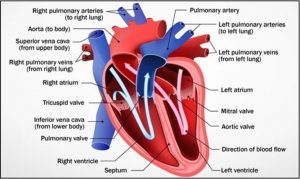Heart disease comes in many forms, but the two main categories would be acquired and congenital disease.
Congenital disease is where a heart problem is present from birth whereas acquired disease occurs later in life. This article will discuss acquired heart disease for which there are two main types in dogs: mitral valve disease (MVD) and dilated cardiomyopathy (DCM).

Mitral Valve Disease (MVD)
When the heart beats to pump blood around the body a valve should close to stop blood moving from the left ventricle chamber (which supplies the body) and the left atrium chamber (which receives oxygenated blood from the lungs and pumps it into the left ventricle). In MVD this valve closes but there is a small gap in the valve allowing for leakage of blood in the wrong direction. This causes an audible heart murmur which is heard as a ‘whooshing’ noise using a stethoscope. This over time causes enlargement of the left atrium due to increased pressure in this chamber which in turn can press against the windpipe causing a cough.
Dilated Cardiomyopathy (DCM)
Dilated cardiomyopathy is where the heart has a disease of the muscle where over time the heart becomes globular in shape and markedly enlarged and becomes unable to beat properly. A heart murmur tends to be heard further into the disease, as when the heart enlarges, the valves are pulled apart leaving a gap much like in MVD. This means that heart disease can be present with no overt symptoms or murmurs being present even in the face of quite advanced DCM and unfortunately this can lead to sudden death.
Predispositions
Although any dog can get either of the above conditions certain breeds of dog are more prone to one or the other. Smaller breeds of dog (such as Cavalier king Charles spaniels, terriers etc.) are more prone to MVD but larger dogs including Greyhounds are more prone to DCM.
Congestive Heart Failure
In mainly MVD but also in DCM often the end point is that the heart is unable to meet the body’s requirements and then this leads to congestive heart failure (CHF). This is when the heart is not working efficiently enough leading to a backlog of blood flow causing fluid to build up in the lungs. This in turn makes it harder for the heart to work and also leads to coughing.
Diagnosis:
The way we diagnose these cases is by listening for murmurs or abnormal rhythms, ultrasound to actually visualise the heart, x-rays to check for fluid in the lungs and heart size and ECGs (electrocardiograms) to assess the electrical activity of the heart.
Treatment:
Treatment of CHF involves three main drugs, one to improve how well the heart pumps, one to reduce the work the heart has to do and one to remove excess fluid building up in the lungs. In the past few years one of these drugs has been proven to give an extra 15 months of symptom free life. This requires dogs with significant heart murmurs to have a heart scan to assess if the drug would be appropriate.
How to monitor at home:
The main symptoms to be aware of are coughing, exercise intolerance, increased resting respiratory rate (should be <35 breaths per minute when asleep) and fainting or collapse. If any of these are occurring, then you should take a trip to the vet for a check.
 Dr Alex Howell, Willett House Veterinary Surgeons
Dr Alex Howell, Willett House Veterinary Surgeons
